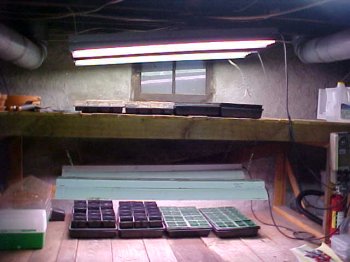
*Indoor seed starting*

Many years ago I decided to expand upon my seed starting by making some kind of grow light setup in my basement. I figured that with some of my family in law enforcement I could find out where to get some good lights. I was advised to check out the next Sheriffís sale where I picked up a couple of high intensity lights that some local pot grower had lost in a raid, they were cheap enough so I was in business. Well, before I checked into the actual intensity of these bulbs I quickly burnt up several flats of tomato seedlings. I had the flats much too close to the light and I paid the price. They worked great for older seedlings and houseplants or with less intense bulbs; but you have to be very careful and I needed to be able to only check on them every couple of days and I also needed to be able to adjust the light distance for growing plants easily and quickly. (When the oneís from the Sheriffís sale finally died, I didnít bother to replace them as the fluorescent lights suit my purpose much better.)
Thinking I needed to educate myself I spoke with every horticulture expert, greenhouse operator, gardener and farmer in the surrounding counties as well as e-mailed experts, authors and Purdue professors. The seed companies were also a wealth of information, many company reps I spoke with were extremely knowledgeable about starting seeds under lights. I researched this into the ground! Then I tailored my setup to my needs. I would start all my own plants in my damp dungeon of a basement - the furnace room in my basement was a dark, scary place. The perfect spot to start my garden!
More practical for starting flats of seeds is the 4 foot fluorescent lights. I rummaged around in one of our buildings until I found a couple that werenít being used, liberated them, and then I bought a couple more. I recommend getting good ones which can have the ballasts replaced; they cost more than the cheap Wal-mart oneís, but they are worth it. Itís relatively easy to replace a ballast, and definitely cheaper than buying a whole new light every time one quits working.
I have a very simple setup. A couple of steel sawhorses (liberated them from my Dad - he knows there missing, but canít remember where he put them!), some old crating made into a tabletop and a shelf, and *VIOLA* the racks for the flats. The table runs north and south and my lights run north and south in a series of two on each level. This allows me to put 4 flats under the lamps running east and west. With two levels of this it allows me to start 8 flats at one time. I can also start twice as many flats by rotating them. Rotate first thing in the morning and right before dinner - 6am and 6pm.
The bulbs I use are specifically for plants and aquariums. I order them by the case from our local Peerless Electric, but Iíve seen them at Wal-mart too. They are a bit pricier than a regular fluorescent bulb, but they are just the right intensity for plants and do a better job with starting vegetable seeds. For some reason at my house they last better on a timer than the regular bulbs do.
I recommend hanging the lights on chains so the distance from the plants can be adjusted easily. Having the right distance from the plants and the amount of time the light is on will greatly affect the spindly-ness of the plants. When tomato plants start looking too leggy, they are getting too much light too far from them. These lights should be kept within a few inches of the dirt (when seeds are first planted) or the top of the plant. Also, I start most of my seedlings (tomato and pepper plants) out with only 6 hours of light per day. Starting at 3 or 4 weeks I increase it a half hour a week until they get about 10 hours a day (very easily done with the aid of a timer!). By that time itís often time to start hardening off the plants, getting them ready to transplant outside. Other plants need different lighting requirements, but tomatoes and peppers seem to be the ones people like to grow the best. If you have any questions about the amount of lighting, donít hesitate to call the seed manufacturer and see what they recommend for the different varieties in the area you live.
Another area that needs to be addressed is when the proper time to start seeds indoors actually is. Well, this one is tricky because you may not want to follow the directions on the seed package to the "T". Consider the current weather and climate conditions as well as the long range forcast. I always start cabbage on Ground Hog day, mainly because itís become tradition and itís hardy enough to go outside when itís still a little chilly. But, Iíve also got plenty of cover for them if we get a late snow! But always remember your transplant times are going to be different every year depending on Mother Nature so have a plan B , plan C and maybe even plan D ready to implement if things donít go as planned. Iíve had a couple of years that I had broccoli and cauliflower harvested before Memorial Day and I live in Indiana, yet there have also been years that I didnít get a decent tomato until August!
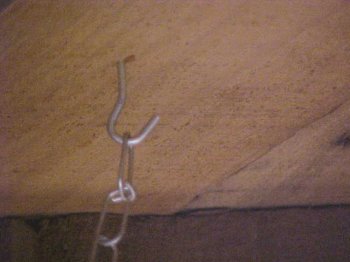
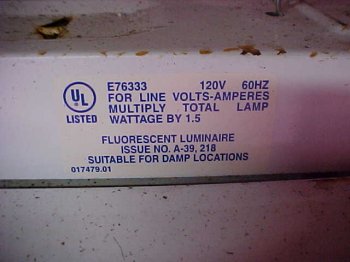
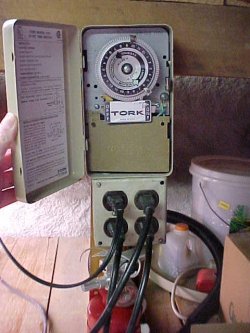
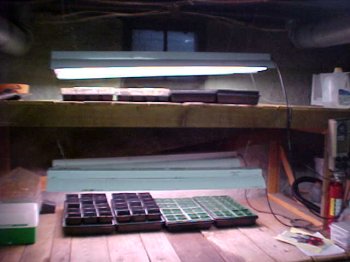
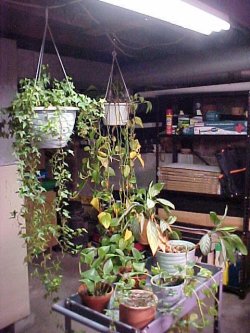
www.alpharubicon.com
All materials at this site not otherwise credited are Copyright © 1996 - 2005 Trip Williams. All rights reserved. May be reproduced for personal use only. Use of any material contained herein is subject to stated terms or written permission.